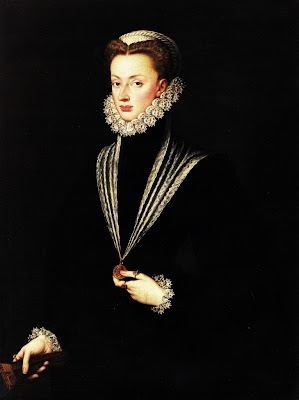11/22/11 – Plaza de las Descalzas, 3
Before it became a refuge for five centuries of barefoot nuns, the Monasterio de las Descalzas Reales was a medieval palace of the famously inbred Habsburg royal family.
 |
| Tour entrance at left |
Joan of Austria was born in here in 1536. She was married to a double first cousin in Portugal, who impregnated her and then promptly died. Joan was called back to Madrid in 1554 by her brother King Phillip II, to rule for him while he lived in England, leaving her baby (named Sebastian—an uncommon moniker at the time) to be raised in Portugal. She never saw Sebastian again. In 1559, Joan turned the palace into a convent for women of the royal household, including herself. She remained single and died at age 38. Today about 20 nuns reside in the convent unseen, their choice of footwear unknown.
 |
| Joan of Austria, age 25 |
The Monasterio (nun = monja in Spanish) is located close to the center of Madrid. If you arrive at 11 and can’t get a tour until noon, there are dozens of nearby distractions, including Starbucks and the Chocolatería San Ginés. The building was designed early in the 16th century by royal architect Juan Bautista de Toledo (see my report on the Musem of the Sewers of Peral). The hour-long, guided tour in Spanish (and perhaps in English, when there are enough takers) costs 7 euros. The guide speaks very quickly, and lot of basic information is covered, but not what one really wants to know. Where are the nuns? What do they do all day? Why are there two separate paintings of girls holding dishes of eyeballs?
Even if you don’t speak a work of Spanish, it is well worth tagging along to inhale the medieval atmosphere: the staircase frescos, family portraits, religious treasures, tiny chapels, and a vast chamber of floor-to-ceiling tapestries based on designs by Rubens.
 |
| Main staircase leading to cloister |
Over the centuries, the dowries of noblewomen enriched the convent’s art collection. The most valuable painting here is Caesar’s Money, by Titian. As for the eyeballs, a quick search of religious symbology in gothic art suggests that the eyeballs are held by Saint Lucy (283-304), a wealthy young girl whose eyes were gouged out as punishment for steadfastly guarding her virginity and refusing to marry a pagan. A fitting subject for a convent of recluses.
The shiny brick floor of the cloister is not original, but the Talavera tiles that line the walls and chapels are authentic, and beautiful. The cloister on the second floor looks down upon a symmetrical garden of orange trees and a fountain. One fully expects a unicorn to canter by.

No comments:
Post a Comment